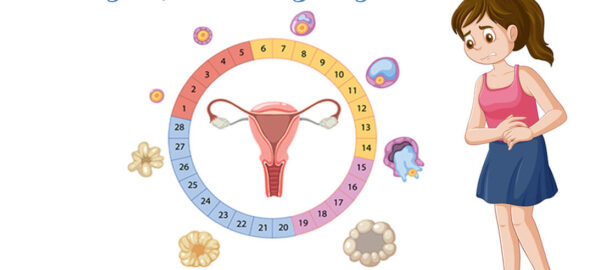
Image by master1305 on Freepik
Menstrual cycles are a fundamental aspect of a woman’s reproductive health. However, many women experience irregular periods, which can be bothersome and even concerning. Various factors, such as hormonal imbalances, stress, diet, or underlying health conditions, can cause irregular periods and the advantages of exercising during menstrual cycles, the possibility of exercise aiding in regulating and treating periods, and the use of medicine to take for irregular periods.
Understanding Menstrual Irregularities:
Before delving into the influence of exercise, it’s essential to understand irregular periods. Menstrual irregularities are deviations from the normal menstrual cycle, typically lasting around 28 days. Irregular periods can manifest in various ways, such as missed periods, frequent periods, or unpredictable cycles. The causes behind these irregularities can be diverse, ranging from hormonal imbalances to stress and lifestyle factors.
It’s important to note that medical conditions like PCOS, thyroid disorders, or significant weight fluctuations may also be linked to this. Women experiencing irregular periods may have shorter or longer cycles, unpredictable menstrual bleeding, or missed periods altogether. Understanding the underlying causes of irregular periods is crucial for effective management and potential treatment and recognizing when medical evaluation may be necessary to rule out any underlying health concerns.
Benefits of Exercise:
Engaging in exercises can provide numerous advantages for women who suffer from irregular menstrual cycles. While exercise alone may not completely cure irregular periods, it can significantly contribute to managing and improving menstrual cycle regularity. Here are the detailed benefits of activities for irregular periods:
1. Hormonal Balance:
Consistently participating in physical activity can have a significant impact on hormonal regulation. Hormones like estrogen and progesterone serve critical roles in the menstrual cycle. Keeping them in balance is crucial to ensure regular periods. Exercise helps improve hormone production and sensitivity, leading to a more stable hormonal environment. By promoting hormonal balance, exercise can help restore regularity to menstrual cycles that have been disrupted due to hormonal imbalances.
2. Stress Reduction:
Stress can greatly impact the delicate hormonal balance in the body, which may result in irregular menstrual cycles. Physical activity positively impacts stress reduction and the stimulation of endorphin release. These naturally occurring chemicals are known to produce pleasurable feelings and reduce anxiousness. Reducing stress levels through exercise can positively impact the menstrual cycle and contribute to more regular periods.
3. Improved Blood Circulation:
Physical activity, especially cardiovascular exercises, improves blood circulation throughout the body, including the pelvic region. Enhanced blood flow to the reproductive organs can promote better functioning and support the normal shedding of the uterine lining during menstruation. Improved blood circulation can also help alleviate menstrual cramps and reduce discomfort during periods.
4. Weight Management:
Maintaining an appropriate weight is key to promoting good health and hormonal balance. Regular exercise aids in burning calories, increasing metabolism, and managing body weight. Excess body weight can lead to hormonal imbalances, insulin resistance, and disruptions in the menstrual cycle. The combination of regular exercise and maintaining a healthy weight can lead to improved menstrual regularity for women.
5. Regulation of Ovulation:
Irregular periods can result from irregular ovulation, where the release of an egg from the ovaries is not occurring regularly. Exercise can positively influence the hypothalamus and pituitary gland, which play key roles in regulating ovulation. Regular ovulation promotes a more predictable menstrual cycle and can contribute to more regular periods.
6. Psychological Well-being:
The practice of regular exercise is connected to better emotional health, reducing symptoms of anxiety and depression. Women experiencing irregular periods may face emotional stress and frustration. Exercise can be a natural mood booster, reducing negative emotions and enhancing psychological well-being. Positive mental health can indirectly contribute to hormonal balance and menstrual regularity.
7. Positive Impact on PCOS:
Polycystic ovary syndrome (PCOS) is a common hormonal disorder that often leads to irregular periods. Exercise is particularly beneficial for women with PCOS, as it helps improve insulin sensitivity, regulate hormonal levels, and manage weight. These factors can positively impact menstrual regularity and the management of PCOS symptoms.
8. Lifestyle Habits and Cycle Awareness:
Incorporating exercise into daily routines encourages a healthy lifestyle. Women who participate in regular physical activity tend to adopt additional healthy behaviours, such as consuming a well-balanced diet and ensuring adequate sleep. A holistic approach to health can support menstrual regularity. Additionally, tracking exercise habits and menstrual cycles can help women become more aware of any patterns or changes in their processes, leading to better management of irregular periods.
Influence of Exercise on Menstrual Cycles
Regular exercise has been proven to contribute positively to menstrual cycle regulation. Physical activity boosts circulation, reduces stress, and promotes hormonal balance. Maintaining healthy body weight is important for regular menstrual cycles. Maintaining a healthy weight increases the likelihood of regular menstrual cycles for women.
It’s important to note that excessive exercise, such as intense training for athletic competitions, may have the opposite effect and lead to amenorrhea (absence of menstruation). Striking the right balance is key to reaping the benefits of exercise for menstrual health.
When managing irregular periods, no single exercise can guarantee a cure, as various factors can influence the condition. However, incorporating regular physical activity with medicine to treat irregular periods into your routine can promote hormonal balance, reduce stress, and improve overall health, all of which can positively impact menstrual regularity. Below are some exercises that are considered beneficial for women with irregular periods:
Cardiovascular Exercises:
Cardiovascular or aerobic exercises increase your heart rate and involve continuous movement of large muscle groups. These exercises improve blood circulation, boost metabolism, and promote hormonal balance. Some effective cardiovascular activities include:
a) Running/Jogging: Running or jogging at a moderate pace for about 30 minutes a few times a week can help regulate hormones and enhance overall fitness.
b) Cycling: Whether indoors or outdoors, this cardiovascular exercise is low-impact on the joints and offers numerous benefits for the cardiovascular system.
c) Swimming: Swimming is a full-body workout that improves circulation, reduces stress, and helps maintain a healthy weight.
Yoga:
A mindful practice, yoga integrates physical postures, conscious breathing, and meditation for a harmonious mind-body experience. It is well-known for its stress-reducing benefits and its ability to support hormone regulation. Some yoga poses that may be beneficial for irregular periods include:
a) Butterfly Pose (Baddha Konasana): This pose opens the pelvic area, stimulates abdominal organs, and can help regulate the menstrual cycle.
b) Bridge Pose (Setu Bandhasana): The bridge pose stretches the abdomen and pelvic region, promoting blood flow to the reproductive organs.
c) Child’s Pose (Balasana): This calming posture aids in reducing stress and tension, contributing to restoring hormonal balance.
Pilates:
Pilates is a low-impact exercise focusing on core strength, flexibility, and overall body awareness. Supporting the reproductive organs can be achieved through the strengthening of the pelvic floor muscles. Some beneficial Pilates exercises for irregular periods include:
a) Pelvic Curl: This exercise strengthens the lower back and pelvic area, promoting stability in the reproductive region.
b) Leg Circles: Leg circles engage the core and pelvic muscles, helping to improve circulation in the pelvic region.
Strength Training:
Strength training involves resistance exercises that target various muscle groups. Building muscle mass can help regulate hormones and boost metabolism. Some effective strength training exercises include:
a) Squats: Squats engage the lower body muscles, including the pelvic region, and can improve blood flow to the reproductive organs.
b) Deadlifts: Deadlifts work multiple muscle groups and can contribute to hormonal balance when performed properly.
c) Kegel Exercises: Kegels involve contracting and relaxing the pelvic floor muscles, which can benefit women experiencing irregular periods.
Conclusion
In the pursuit of optimal well-being, incorporating regular exercise is a fundamental pillar and influences the regulation of menstrual cycles. You can positively impact hormonal balance and reduce stress by including physical activity and irregular periods treatment medicine in your daily routine. The key to success is selecting activities that you find enjoyable and can continue for the long term. Remember that every woman’s body is different, and managing irregular periods requires a holistic approach that may involve lifestyle adjustments, exercise, and medical advice. Finding the right combination of these factors is essential for promoting a healthier and happier life for women.










